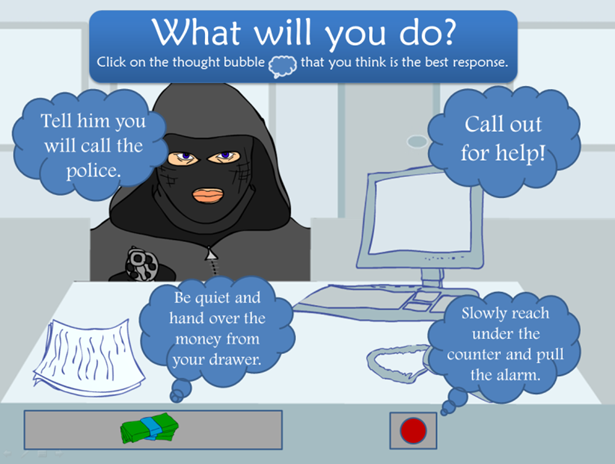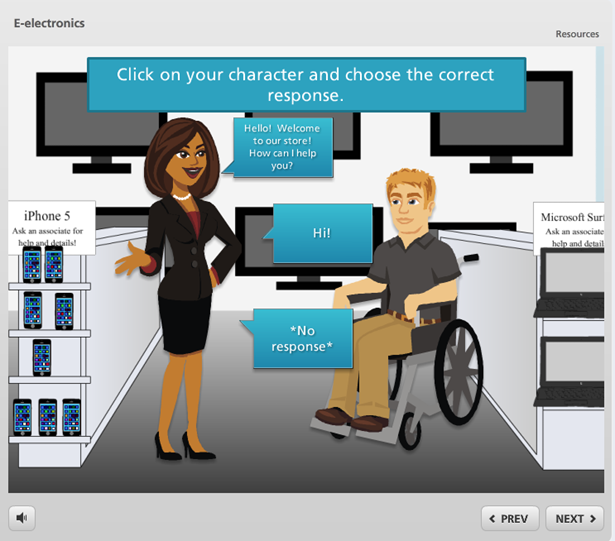ATD Blog
Interactive Elements in E-Learning
Thu Apr 11 2013


We’ve all seen it…the “page-turner” style e-learning module that shows you slide after slide of text. Sometimes the text may even be accompanied by a picture or some audio. Whatever the content, you find yourself hitting the “next” arrow as quickly as possible to avoid falling asleep entirely. Before entering the training and development field, I can tell you that this was something I had come to expect when I sat down for on-the-job training.
However, I can see now that most instructional designers in the field are transitioning away from using a series of PowerPoint slides with bullet points and trying to find ways to add a level of interactivity to their learning solutions. Interactivity is being discussed with words like “engagement” and “motivation.” The idea is that if students are forced to stop and interact with the module in some way, they will focus on the content more fully. By doing this, the rate of retention will increase and the module is more effective.
Interactions don’t have to be elaborate to be effective
I started my career working for animation and video game companies, so when I moved into training, I had preconceived notions about the difficulty of creating interactive content. To me—and to many companies—interactivity equates to more technology and a higher budget. But I have found that this is not necessarily the case. There are a variety of simple interactions that you can add to your basic PowerPoint slide if you are creative enough. Remember, the end goal is not flashy visuals, it is knowledge retention.
Simple additions to your modules can make all the difference to your learners. A drag-and-drop page or information tabs can be just as effective in the right situation as a complex CG-simulated game. Try adding in a VoiceThread or wiki page that allows students to contribute and reflect on their lesson. Using a tool like Hot Potatoes can help you create crossword puzzles, fill-in-the blank questions, or jumbled sentence exercises. Indeed, there are any number of free or inexpensive tools out there waiting to help you create new instructional strategies for your courses.
Certain situations may merit experimenting with more involved interactions. A branching simulation can be a great way to teach concepts like customer service skills or dealing with high-stress situations. A video or animation may be the best way to lead into a complex scenario for the learner to puzzle through to completion. Virtual worlds can be used to show students a world they never would have seen otherwise, and to draw virtual learners together. Augmented reality could be explored to get students moving around in their environment and viewing it through new eyes. The concept of gamification shows us that we can use game elements to enhance learning, adding tools such as levels, points, or badges.
There are some great tools out there to help you make more involved interactions for your modules. Articulate Storyline has built-in features that help create interactions using layers and triggers, as well as a variety of other tools. GameMaker Studio is a program that has a user-friendly visual interface, but still allows for more intense programming for a simulation or educational game. The Adobe Creative Suite has every program you would likely need to create some superb graphics, videos, and effects to add into your interactions.

How far is too far?
To be sure, interactivity can add a level of creativity and engagement to your e-learning modules. But keep in mind that the interaction needs to be instructionally sound and relevant. If you make a high-budget simulation with no instructional backing, you end up wasting the time and effort of both yourself and your learners. To help determine the best type of interaction, answer a few simple questions:
Will it benefit the learner most to reflect, react, or make decisions?
What is the most relevant to the content to the learner's goals?
Remember, going overboard with interactions will actually distract learners from the content you are trying to teach.
The important thing is to focus on the needs of the learner. A good mixture of content and interactions will help learners retain knowledge gained from the lesson. And if you are unsure of where to start, you can draw inspiration from similar projects. For example, something like diversity training has been done by other instructional designers, so try to find what strategies they used that might also work for your module.
Once you decide what type of interaction will best fit the situation, determine what resources you have at your command. Factors to consider are your time, your budget, and most importantly your creativity. Use your tools to their fullest, trying to be as creative as possible. Finally, test your interactions to evaluate their impact on your learners.
Together, we can all move away from “page-turner” e-learning modules into a new world where courses are motivating for the students.
